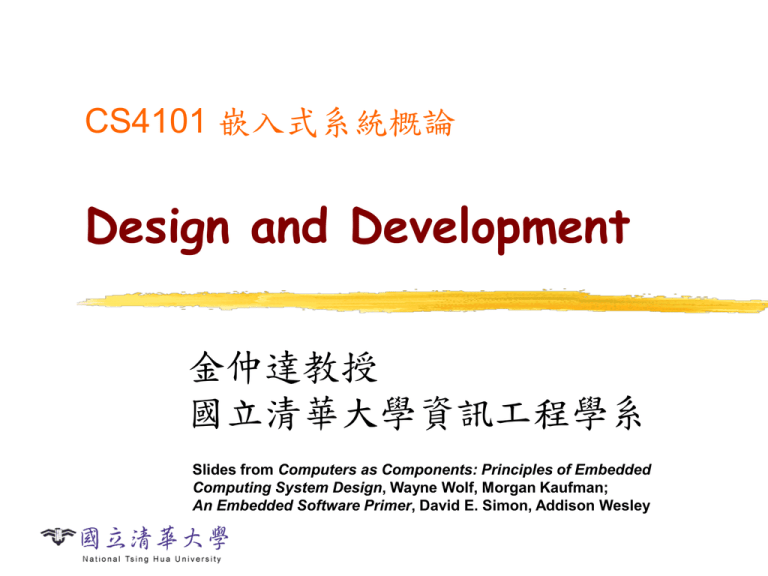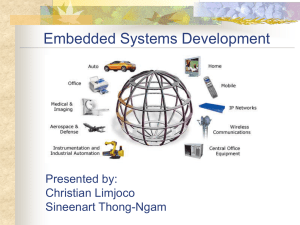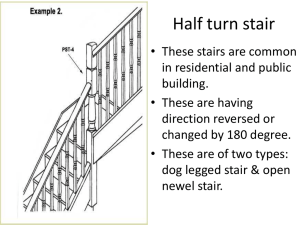L01-design - 國立清華大學開放式課程OpenCourseWare(NTHU
advertisement

CS4101 嵌入式系統概論 Design and Development 金仲達教授 國立清華大學資訊工程學系 Slides from Computers as Components: Principles of Embedded Computing System Design, Wayne Wolf, Morgan Kaufman; An Embedded Software Primer, David E. Simon, Addison Wesley Recap More and more physical things will be augmented or embedded with computing Things become “smarter” Computing becomes ubiquitous An embedded system is a system that is embedded with programmable computers for specific applications of that system Why embedded systems? Faster, more flexible development at lower cost More complex functionalities 1 Suppose You Have a Product Idea To develop a device that can record, for each day, the number of stairs that the user has climbed up or down From this number, we can then calculate the amount of CO2 saved and calories burned Let us call this device stair counter How to start from here? 2 Typical Design Flow requirements Top-down design specification architecture Real design often iterative Bottom-up design component development system integration 3 Requirements Plain language description of what the user wants and expects to get e.g. to develop a device that can record, for each day, the number of stairs that the user has climbed up or down Describe how the end product is used by the user requirements specification architecture component development system integration May be developed in several ways: talking directly to customers talking to marketing representatives providing prototypes to users for comment 4 Requirements Often need to know target customers and business model Stair counter as an add-on of cell phone Stair counter as a consumer product Stair counter as a gift … 5 Requirements Functional requirements: Internals as a black box and describe only the outputs as a function of input; Show number of stairs climbed up or down Show amount of CO2 saved Do not count in other cases Non-functional requirements: Performance, reliability, etc. Size, weight, etc. Power consumption Describe “WHAT”, not “HOW” Cost … 6 Requirements Form name purpose inputs outputs performance manufacturing cost power physical size/weight Stair counter Count and show stairs climbed and CO2 saved Power-on/off button Back-lit LCD 200 X 300 Update on every step $150 100 mW No more than 2” X 3”, 4 oz. 7 Specification More precise, usually quantitative description of the system: Should not imply a particular architecture List assumptions e.g., update screen 0.25 sec after each step, error rate < 95%, cost < $300 requirements specification architecture component development system integration May include functional and non-functional elements May be executable or may be in mathematical form for proofs e.g. UML (Unified Modeling Language) 8 Architecture Design What major components satisfy the specification? HOW requirements specification architecture Need to know what are available Hardware components: CPUs, peripherals, etc. e.g. MSP430 CPU, 3-axis accelerometer Software components: component development system integration Major programs and their operations e.g. no OS, accelerometer driver, LCD driver Must take into account functional and nonfunctional specifications 9 Design Considerations Environment which the embedded system is in External and internal stimulus sources that interact with the embedded system I/O Actions and events caused by stimulus Elements of the embedded system that could be affected by the stimulus Desired system responses to the stimulus, which reflects one or more system requirements algorithm/workflow How the system responses can be measures 10 Component Development Actual implementation of individual hardware and software components requirements specification architecture Must spend time architecting the system before you start coding Some components are ready-made, some can be modified from existing designs, others are to be designed from scratch component development system integration e.g. MSP430 CPU, 3-axis accelerometer Good surveys help 11 System Integration Put together the components Many bugs appear only at this stage Require good interface definition from the start Have a plan for integrating components to uncover bugs quickly, test as much functionality as early as possible test and verification requirements specification architecture component development system integration 12 System Development Now that you have better idea of the requirements, specifications, and architecture of the stair counter How to proceed to develop the components and integrate the system? But, Real hardware? Programming environment? requirements specification architecture component development system integration 13 Development Environment Host: a computer running programming tools for development Target: the HW on which code will run After program is written, compiled, assembled and linked, it is transferred to the target MSP430 X86 Host system Target system 14 What If Real HW Not Available? Development board: Before real hardware is built, software can be developed and tested using development boards Development boards usually have the same CPU as the end product and provide many IO peripherals for the developed software to use as if it were running on the real end product Tools for program development Integrated Development Environment (IDE): cross compiler, linker, loader, … OS and related libraries and packages 15 Cross Compiler Runs on host but generates code for target Target usually have different architecture from host. Hence compiler on host has to produce binary instructions that will be understood by target 16 Development Process Process for creating instructions that are built on host but meant for the target Tools are compatible with each other a toolchain Binutils: as, ld Glibc:C runtime Lib GCC:C/C++ compiler 17 Linker/Locators For computers: For embedded systems: Linker: creates an image file to be run on host Loader: loads image file into memory during run-time Locater: creates a file, containing binary image or other format, that will be copied onto target, which run on its own (not through loader) It needs exact addresses beforehand Certain parts of program need in ROM and some in RAM Normally done by dividing program in segments Locator needs to be told where in memory to place segments 18 Summary Development of a system usually involves: Requirement, specification, architecture design, component development, system integration, test and validation Development environment of an embedded system often includes Development host with toolchain: cross compiler, linker/loader, library, emulator Development board 19











